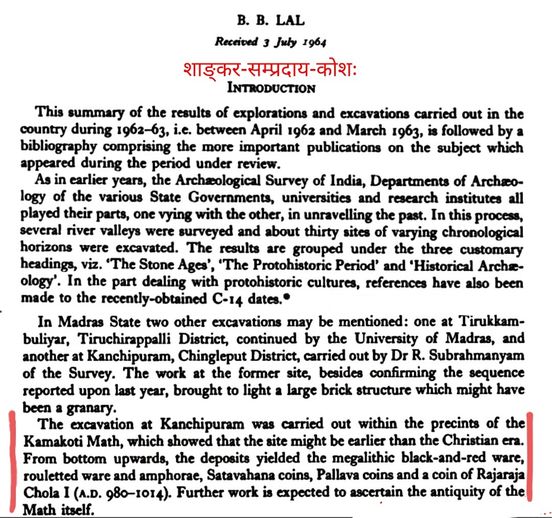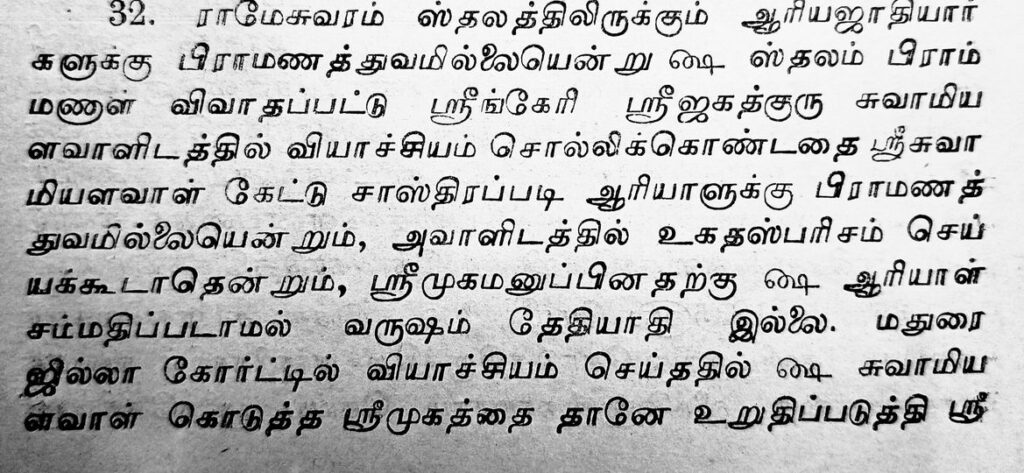ஸ்ரீகோவிலூர் மடாதிபதி அவர்களது பொருளுதவியைக்கொண்டு1918ஆம் ஆண்டு வெளியான ஸ்ரீசங்கர விஜயத்தில் காஞ்சிபுரம் உள்ளிட்ட இடங்களில் மடங்கள் ஸ்தாபித்தமை பற்றிய குறிப்பு :-
“ஸ்ரீ கந்தபுராணம் சிவரஹஸிய கண்டம் நவாம்சம் பதினாறாவது அத்யாயத்துள்ளும் சிவபுராணத்துள்ளும் தேவர்களாற் கூறப்பட்டிருக்கிற ஸ்ரீமத் சங்கராசார்ய ஸ்வாமி சரித்திரம், வியாஸர் முதலிய முனிவர்களாலும், ஸ்வாமிகளது காலத்திலிருந்து அவர்களோடு உண்டு, உடுத்து உலகியல், ஆன்மவியல் இரண்டிலும் அவர்களுடன் அனுபவத்திலிருந்து வந்த எம் ஆசிரிய பரம்பரைகளாலும் எழுதப் பெற்றிருந்த நூல்களின் ஆதாரங்கொண்டும், சித்விலாஸ ஸ்வாமி, விஞ்ஞான ஸ்வாமியாகிய ஸந்யாஸிகள் எழுதிவைத்துள்ள சங்கர விஜய விலாசம் என்னும் நூலின் துணைகொண்டும், வியாஸாசலீய மஹாகாவியத்தின் உதவிபெற்றும், பத்மபாதர் எழுதிய சரித்திரத்தின் உத்தமோபசாரங் கொண்டும் இச்சரித்திரம் எழுதப் பெற்றிருக்கிறது.
…
பிறகு ஸ்வாமி திக்விஜயம் செய்யப் புறப்பட்டுக் காஞ்சீபுரத்தில் ஒரு மடமும் ஐகன்னாதத்தில் ஒரு மடமும் துவாரகையில் ஒரு மடமும் பதரிகாச்ரமத்தில் ஒரு மடமும் ஸ்தாபித்தார்கள்.”
சமிவன க்ஷேத்திரமென்னும்
செட்டிநாட்டுக் கோவிலூர் மடம் அத்துவித மரபினது; இம்மடம் துங்கா ச்ருங்கேரி மடத்துடன் நீண்ட காலத் தொடர்பு உடையது மைசூரார் சொல்வர். இம்மடத்தின் அதிபராக விளங்கிய தவமுனிவரின் பொருளுதவியைக் கொண்டு சிவரஹஸ்யம், சித்விலாஸீயம், வ்யாஸாசலீயம் உள்ளிட்டவற்றின் அடிப்படையில் ஸ்ரீ சங்கரபகவத் பாதாசார்ய ஸ்வாமிகள் சரித்திரம் என்னும் இந்நூல் வெளிவந்துள்ளது.
காரைக்குடி கம்பராமாயண ப்ரசாரகர் மோ.வெ. கோவிந்தராஜ ஐயங்கார் எழுதிய இந்த சரித்திர நூல் 1918ஆம் ஆண்டு இலவச வெளியீடாக வழங்கப்பட்டது.












